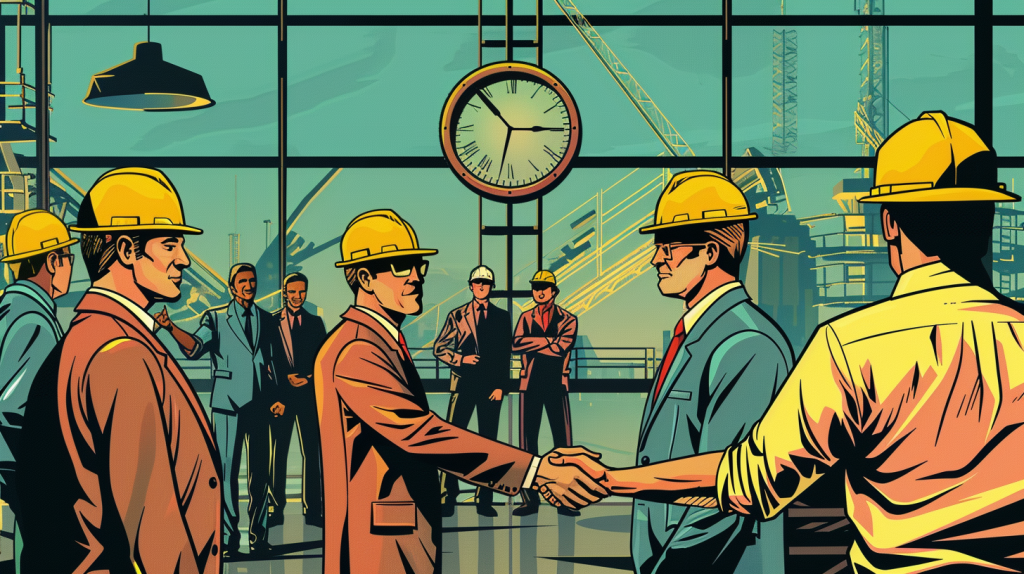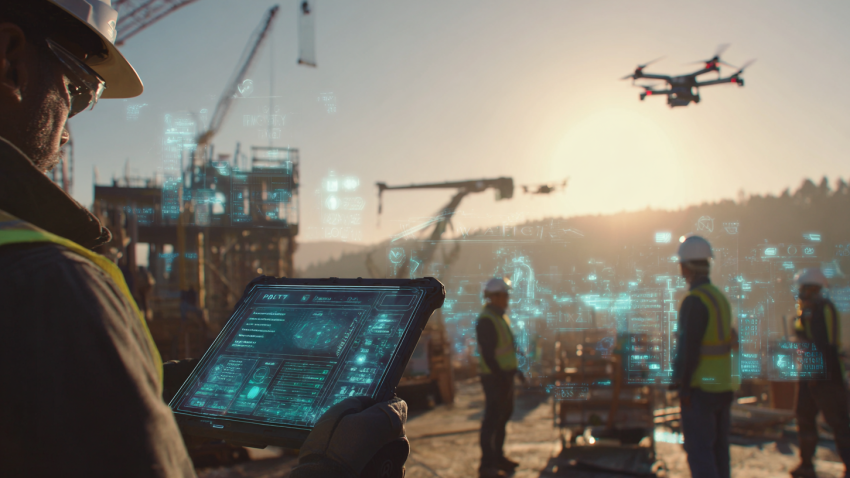Best Guide to Solar Farm Construction Management: Top Solar Construction Management Software for Tracking Projects, Deliveries, and Compliance
Table of Contents:
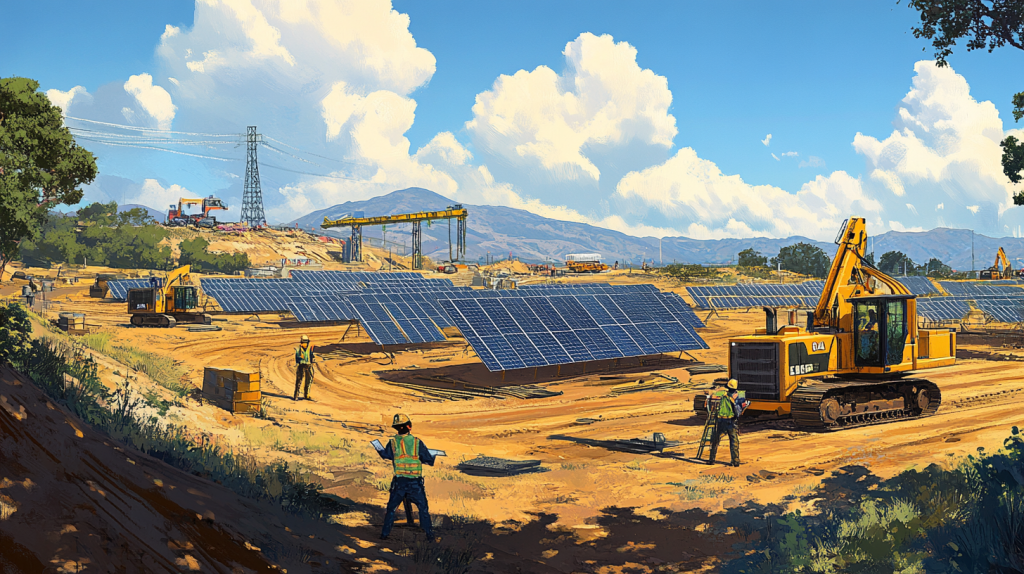
The rise of renewable energy projects has led to a growing need for efficient solar farm construction management. With large-scale solar projects requiring precise coordination of materials, crews, and compliance regulations, contractors and project managers must adopt advanced construction management software to streamline operations.
Managing solar farm construction involves supply chain logistics, workforce scheduling, regulatory compliance, and project tracking. Delays in material deliveries, crew assignments, or permitting can lead to cost overruns and missed energy production targets. The right solar construction management software ensures smooth project execution by automating scheduling, tracking deliveries, and ensuring compliance with environmental and safety regulations.
This guide explores the best practices, top software solutions, and key features needed for successful solar farm construction management in 2025.
Understanding Solar Farm Construction Management
Solar farm construction involves multiple stages, including site selection, permitting, equipment procurement, installation, and final commissioning. Unlike traditional construction projects, solar farm development requires close coordination between engineers, suppliers, and field teams to ensure timely completion.
Key Challenges in Solar Farm Construction
- Logistics and Delivery Tracking – Ensuring panels, inverters, and racking systems arrive on schedule.
- Workforce Coordination – Managing electrical, mechanical, and installation crews across vast job sites.
- Regulatory Compliance – Adhering to environmental impact laws, grid connection requirements, and safety regulations.
- Site Monitoring and Progress Tracking – Keeping projects on time and within budget with real-time tracking tools.
Why Construction Management Software is Essential
- Automates scheduling to prevent labor conflicts and downtime.
- Tracks deliveries and inventory to ensure materials are available when needed.
- Monitors compliance with permitting and environmental requirements.
Effective solar farm construction management relies on digital tools that streamline project execution, improve communication, and prevent costly delays.

Essential Features to Look for in Solar Construction Management Software
Selecting the right solar farm construction management software requires evaluating features that enhance tracking, workforce management, and compliance automation.When choosing the most suitable construction management software for your solar farm project, it is essential to prioritize features that streamline and automate key aspects of the construction process.
These features should include robust tracking capabilities for monitoring project progress, efficient workforce management tools, and automation features that ensure compliance with industry regulations and standards. By selecting software that excels in these areas, you can optimize your solar farm construction project, improve overall efficiency, and maintain compliance with relevant requirements.
Key Features to Consider
- Project Scheduling & Workforce Coordination
- Automates crew assignments and shift planning based on job site needs.
- Prevents labor bottlenecks and ensures each phase progresses smoothly.
- Delivery & Inventory Tracking
- Monitors shipments of solar panels, transformers, and construction materials.
- Uses GPS and barcode scanning to track materials in real time.
- Compliance & Safety Monitoring
- Generates automated regulatory reports for environmental and grid connection compliance.
- Tracks worker certifications and safety inspections to ensure site compliance.
- Real-Time Reporting & Site Monitoring
- Allows project managers to monitor solar farm progress remotely.
- Uses drones and IoT sensors for site condition monitoring.
- Integration with Renewable Energy Software
- Syncs with grid management platforms for seamless energy production tracking.
- Links with BIM software to optimize panel placement and efficiency.
The best solar farm construction management software offers automated tracking, compliance management, and workforce coordination tools, ensuring projects remain efficient and cost-effective.
Related Articles:
Floating Solar Power: Harnessing Water for the Future of Renewable Energy
Floating Solar Farms: How Offshore Photovoltaics Are Powering the Future of Clean Energy
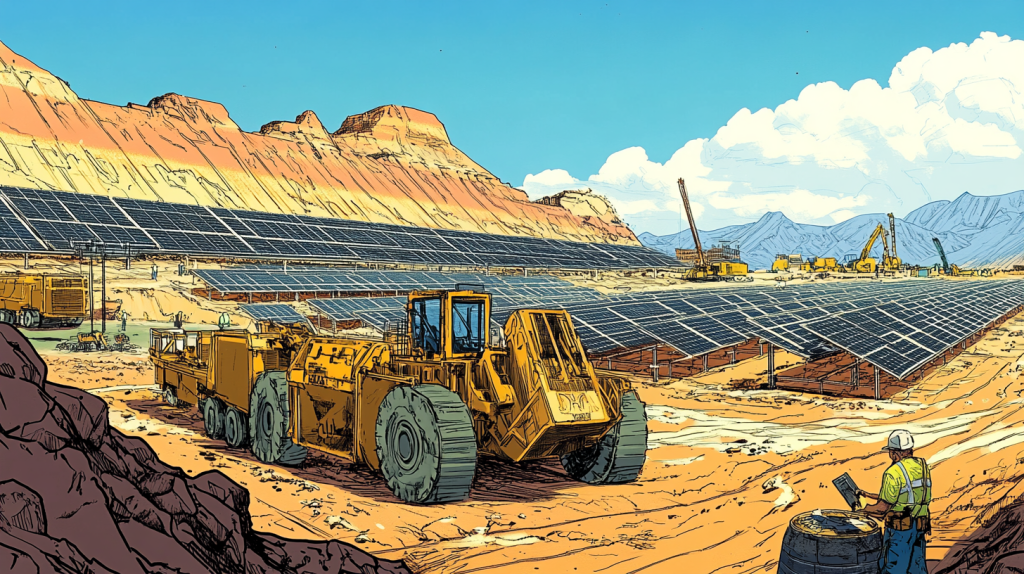
How to Track Solar Farm Construction Progress Efficiently
Managing a solar farm construction timeline requires accurate tracking of tasks, workforce productivity, and supply chain logistics. Without a centralized system, teams often struggle with delays, miscommunication, and resource misallocation.Expanding on the Importance of Centralized Management in Solar Farm Construction
Effectively managing the construction timeline of a solar farm is a complex endeavor that necessitates meticulous tracking of numerous interconnected elements. These include the progression of individual tasks, the productivity of the workforce, and the intricate logistics of the supply chain. When a centralized system is absent, construction teams frequently encounter a cascade of challenges.
Delays become commonplace as tasks fall behind schedule due to unforeseen circumstances or bottlenecks. Miscommunication arises due to the lack of a unified platform for information sharing, leading to misunderstandings, duplicated efforts, and missed deadlines. Resources are often misallocated as a result of poor visibility into overall project needs and progress, resulting in inefficiencies and cost overruns.
Furthermore, without a centralized system, it becomes significantly more difficult to maintain quality control and ensure adherence to safety and environmental standards. The absence of real-time data and insights hinders the ability to proactively identify and address potential issues before they escalate into major problems.
In essence, the lack of a centralized management system in solar farm construction introduces a significant degree of risk and uncertainty. It impedes collaboration, hampers decision-making, and ultimately jeopardizes the successful and timely completion of the project.
Best Practices for Solar Construction Tracking
- Use Cloud-Based Construction Software
- Provides real-time updates on project status, task completion, and material arrivals.
- Enables remote access for stakeholders to monitor site progress.
- Automate Delivery & Logistics Management
- Ensures solar panels, racking systems, and inverters arrive on schedule.
- Uses GPS tracking and automated inventory updates to prevent supply shortages.
- Monitor Workforce Productivity with Mobile Apps
- Tracks installation crew performance, work hours, and task completion rates.
- Reduces idle time by dynamically adjusting schedules.
- Utilize Drones for Aerial Site Surveys
- Conducts real-time site inspections to detect construction delays.
- Ensures proper panel alignment and site layout optimization.
By implementing real-time tracking tools, automated logistics, and workforce monitoring, construction firms can improve project visibility and ensure on-time completion.
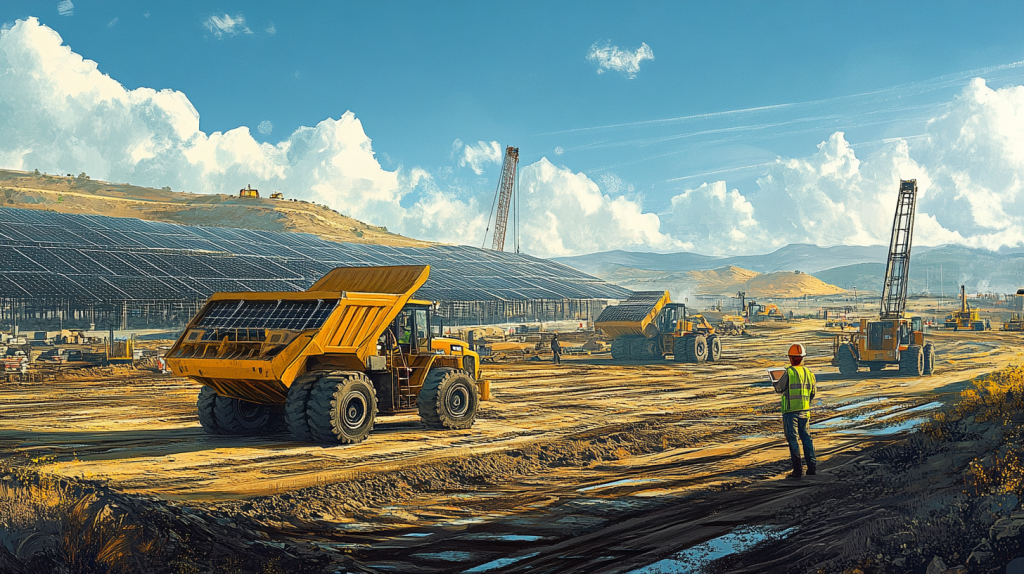
Optimizing Solar Farm Logistics: Tracking Deliveries and Reducing Downtime
Solar farm projects require careful coordination of logistics, as they involve large-scale material deliveries, multiple vendors, and specialized construction equipment. Delays in solar panels, racking systems, or electrical components can lead to costly downtime, missed project deadlines, and increased labor expenses. Solar farm projects necessitate meticulous logistical coordination due to the sheer scale of material deliveries involved. These projects require a vast array of components, including solar panels, racking systems, electrical components, and specialized construction equipment, often sourced from multiple vendors. This intricate supply chain can easily become entangled, leading to potential delays in delivery.
Such delays can have a cascading effect on the project timeline, causing costly downtime, missed deadlines, and increased labor expenses. For instance, if solar panels are delayed, the installation team may be left idle, incurring unnecessary labor costs. Similarly, delays in racking systems or electrical components can hold up the entire construction process, pushing back the project completion date and potentially leading to financial penalties.
Therefore, effective logistics management is critical for successful solar farm construction. This involves careful planning, coordination, and tracking of all material deliveries, as well as proactive communication with vendors to ensure timely delivery and avoid costly disruptions. By streamlining logistics, solar farm projects can be completed on time and within budget, maximizing their potential for clean energy generation.
Key Challenges in Solar Farm Deliveries
- Panel and Equipment Delays – Transporting solar panels and mounting systems over long distances requires advanced logistics tracking to prevent disruptions.
- Storage and Staging Issues – Improper storage or misallocation of solar components leads to damage, loss, or misplaced inventory.
- Last-Minute Schedule Adjustments – Changes in weather, crew availability, or site readiness impact delivery schedules, requiring flexible tracking systems.
Best Practices for Managing Solar Logistics with Construction Management Software
- Use GPS and RFID for Real-Time Delivery Tracking
- StruxHub’s automated shipment tracking ensures that project managers receive real-time updates on solar panel deliveries.
- GPS and RFID technology help prevent material misplacement on-site.
- Automate Scheduling for Just-in-Time Deliveries
- Avoid storing materials too early, reducing the risk of damage, theft, or misallocation.
- StruxHub’s automated scheduling system syncs deliveries with project timelines, ensuring that materials arrive only when needed.
- Improve Warehouse and Job Site Staging
- Organize storage and staging areas so materials are ready for installation without delays.
- Use mobile inventory tracking tools to monitor real-time stock levels and reduce over-ordering.
By automating solar farm logistics and delivery tracking, construction firms can reduce costly downtime, prevent misallocated materials, and improve overall project efficiency.
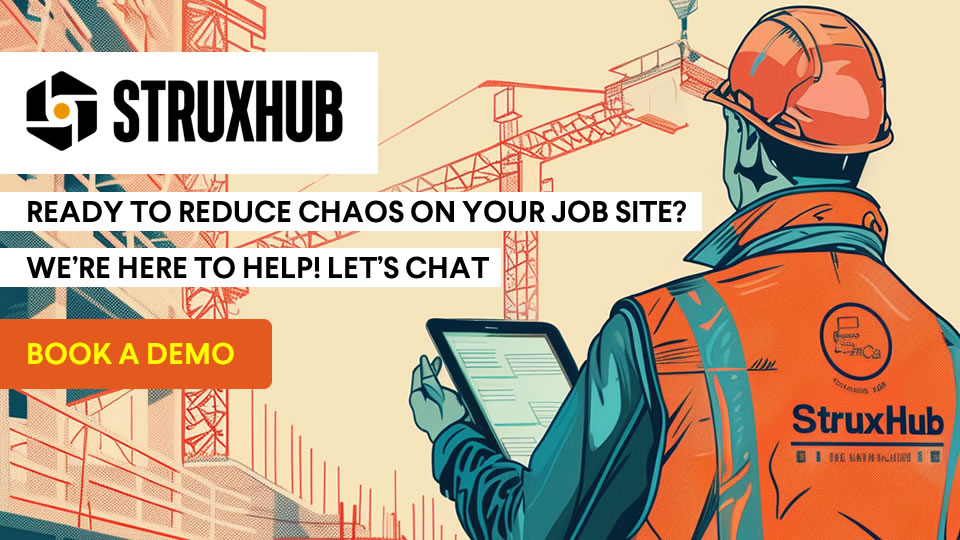
Managing Workforce Productivity in Solar Farm Construction
Labor management is one of the biggest challenges in solar farm construction, as projects involve multiple trade teams, specialized workers, and tight project deadlines. Without proper workforce tracking and scheduling, construction managers risk underutilization, excessive labor costs, and project delays.
Key Workforce Challenges in Solar Farm Projects
- Crew Misalignment – Workers arriving before materials are available or crew shortages delaying installations.
- Labor Fatigue & Overtime Costs – Extended work hours lead to decreased productivity and increased safety risks.
- Skilled Workforce Availability – Solar farm construction requires certified electricians, structural engineers, and installation teams, making workforce planning critical.
How Solar Construction Management Software Improves Workforce Productivity
- Dynamic Crew Scheduling & Shift Management
- StruxHub automates crew scheduling, ensuring that teams are assigned efficiently based on real-time site progress.
- AI-powered scheduling prevents overstaffing or crew shortages, optimizing labor productivity.
- Digital Time Tracking & Labor Reports
- Eliminates manual timesheets by allowing workers to log hours and tasks via mobile apps.
- Tracks overtime hours, shift efficiency, and crew productivity in real time.
- Workforce Certifications & Compliance
- Ensures that all workers on-site are OSHA-certified and meet regulatory requirements.
- Automates compliance tracking for required safety certifications.
By using automated workforce tracking and scheduling tools, construction firms can improve labor efficiency, reduce costs, and ensure compliance with industry regulations.
Related Articles:
Floating Solar Power: Harnessing Water for the Future of Renewable Energy
Floating Solar Farms: How Offshore Photovoltaics Are Powering the Future of Clean Energy
6. Ensuring Safety and Compliance in Solar Farm Construction
Safety and compliance are top priorities in solar farm construction. Workers handle high-voltage systems, heavy lifting operations, and large-scale solar installations, making adherence to OSHA regulations and environmental standards essential.Safety and compliance are paramount in solar farm construction due to the inherent risks involved. Workers regularly handle high-voltage electrical systems, engage in heavy lifting and operation of machinery, and navigate large-scale solar installations. These activities necessitate strict adherence to Occupational Safety and Health Administration (OSHA) regulations to prevent accidents, injuries, and fatalities.
Furthermore, solar farm construction can impact the environment through land clearing, habitat disruption, and potential pollution. Therefore, compliance with environmental standards and regulations is essential to minimize negative environmental effects and ensure sustainable development. This includes measures to control soil erosion, manage stormwater runoff, protect wildlife, and dispose of waste materials properly.
Additionally, solar farm construction projects often involve multiple stakeholders, including contractors, subcontractors, and regulatory agencies. Ensuring compliance with contractual obligations, building codes, and permitting requirements is crucial for successful project delivery and avoiding legal disputes.
Common Safety and Compliance Challenges
- Electrical Safety Risks – Handling high-voltage inverters and panel connections requires adherence to strict electrical safety codes.
- Fall and Equipment Hazards – Workers operate on elevated solar panel structures, increasing the risk of falls and equipment accidents.
- Environmental Compliance Requirements – Solar farms must adhere to land use permits, environmental impact assessments, and grid interconnection standards.
Best Practices for Safety & Compliance Using Construction Management Software
- Automated OSHA Safety Checklists & Incident Reporting
- StruxHub ensures workers complete digital safety checklists before starting shifts.
- Captures real-time safety violations and incidents for compliance tracking.
- Digital Permit & Compliance Tracking
- Tracks all regulatory approvals, land-use permits, and energy production compliance.
- Prevents delays by automating notifications for pending compliance deadlines.
- Real-Time Safety Monitoring via Mobile Apps
- Allows workers to report hazards and request inspections via mobile devices.
- Integrates with IoT sensors and drones to monitor job site safety in real-time.
Automating safety and compliance tracking helps reduce accidents, improve worker protection, and ensure regulatory success, allowing solar farm projects to stay operational without costly shutdowns.

Best Solar Construction Management Software for 2025
Choosing the right software for solar farm construction management is essential for tracking projects, coordinating workforce scheduling, ensuring safety compliance, and managing logistics efficiently. The best software solutions provide cloud-based collaboration, AI-driven scheduling, and real-time tracking tools to help contractors, superintendents, and project managers streamline their operations.
Top 3 Solar Construction Management Software in 2025
- StruxHub – A leading solution for solar farm logistics, workforce coordination, and compliance management. StruxHub ensures that deliveries, job site tracking, and permitting workflows remain seamless throughout the construction process.
- Procore – A popular construction project management software that integrates document sharing, scheduling, and workforce coordination tools.
- Autodesk Construction Cloud – Specializes in BIM modeling and real-time construction tracking, making it ideal for large-scale solar farms requiring precise planning.
Why StruxHub is the Best Choice for Solar Farm Construction
StruxHub offers end-to-end field management tools specifically tailored for solar energy projects, ensuring smooth operations from site preparation to final grid connection.
- Real-Time Delivery Tracking – Prevents delays by monitoring shipments of solar panels, inverters, and transformers.
- AI-Powered Workforce Scheduling – Ensures optimal crew assignments and shift rotations to prevent labor shortages or idle time.
- Automated Safety & Compliance Reports – Simplifies permitting processes and OSHA compliance tracking.
Best Practices
- Choose cloud-based software for real-time job site updates.
- Ensure the software integrates with BIM modeling and renewable energy tracking tools.
- Look for automated logistics tracking to prevent supply chain disruptions.
In 2025, solar farm developers need construction management software that offers real-time tracking, workforce automation, and compliance monitoring. StruxHub provides the tools necessary to keep projects on schedule, within budget, and fully compliant.
Related Articles:
Best Guide to Construction Management Software
The Best Guide to Delivery Management Systems (DMS) for Commercial Construction
How StruxHub Helps Manage Solar Farm Construction
Managing a solar farm construction project requires advanced tracking systems, workforce coordination, and real-time compliance management. Without the right digital tools, project managers risk delays, cost overruns, and regulatory setbacks. StruxHub provides a comprehensive solar construction management solution, ensuring that every stage of the project runs smoothly.
1. End-to-End Solar Farm Logistics Management
StruxHub helps track and optimize material deliveries, inventory management, and job site logistics.
- Prevents material shortages by monitoring shipments and stock levels.
- Uses GPS and RFID tracking to ensure solar panels and mounting systems arrive on-site when needed.
- Syncs material deliveries with workforce schedules to eliminate downtime.
2. AI-Powered Workforce Scheduling
StruxHub automates crew scheduling, labor tracking, and shift coordination.
- Prevents workforce bottlenecks by ensuring crews are assigned efficiently based on project needs.
- Reduces idle time and overtime costs by dynamically adjusting shift planning.
- Ensures that skilled labor teams are deployed at the right phases of construction.
3. Compliance and Permitting Tracking
StruxHub automates safety reporting, environmental permitting, and regulatory compliance workflows.
- Tracks OSHA certifications and worker safety compliance in real-time.
- Automates environmental impact assessments (EIA) and permitting documentation.
- Sends alerts for upcoming regulatory deadlines to prevent permit violations.
4. Mobile Access for Real-Time Field Updates
Superintendents and contractors can access project data from anywhere, enabling:
- Instant job site reporting and issue flagging via mobile devices.
- Live crew tracking and shift status updates.
- Digital document storage for blueprints, permits, and compliance reports.
Key Benefits of Using StruxHub for Solar Construction
- Prevents costly delays by optimizing logistics and crew scheduling.
- Ensures compliance with solar energy regulations and environmental laws.
- Enhances collaboration with real-time mobile updates and automated reports.
StruxHub provides a solar-specific construction management solution, ensuring efficient project tracking, regulatory compliance, and workforce coordination, making it the ideal choice for solar farm developers in 2025.
Compliance and Permitting: Ensuring Regulatory Success
Solar farm construction projects must comply with strict regulatory standards, including environmental impact regulations, safety requirements, and grid connection permits. Missing compliance deadlines or failing to meet permitting requirements can lead to significant fines, project delays, or even project cancellations.
Key Compliance Challenges in Solar Construction
- Environmental Impact Assessments (EIA)
- Solar farms must adhere to land use regulations and environmental protection laws.
- Failure to conduct a proper EIA can lead to fines and project shutdowns.
- Grid Interconnection Permits
- Solar energy projects must be approved for grid connection and energy distribution.
- Compliance tracking ensures that interconnection approvals align with project timelines.
- Safety Regulations & OSHA Compliance
- Workers handling solar panel installations and electrical connections must meet OSHA safety requirements.
- Regular safety audits prevent workplace incidents and liability risks.
How StruxHub Automates Compliance & Permitting
- Tracks All Permitting Requirements in a Centralized System
- Stores permits, safety certifications, and environmental reports in a digital database.
- Automates document submission reminders and compliance alerts.
- Ensures OSHA & Safety Compliance
- Digitally logs worker safety training and equipment inspections.
- Automates job site audits to ensure compliance with OSHA standards.
- Manages Grid Connection Approvals
- Keeps track of interconnection requests and power grid approvals.
- Prevents delays in energy production licensing by ensuring permits are processed on time.
Best Practices for Compliance & Permitting
- Use real-time tracking tools like StruxHub to monitor regulatory deadlines.
- Store all compliance documents digitally to avoid missing critical approvals.
- Conduct regular internal audits to ensure all safety and environmental laws are met.
Compliance is a critical factor in solar farm construction, and StruxHub helps project managers stay on top of regulatory requirements, ensuring that all permits, approvals, and safety standards are met efficiently.
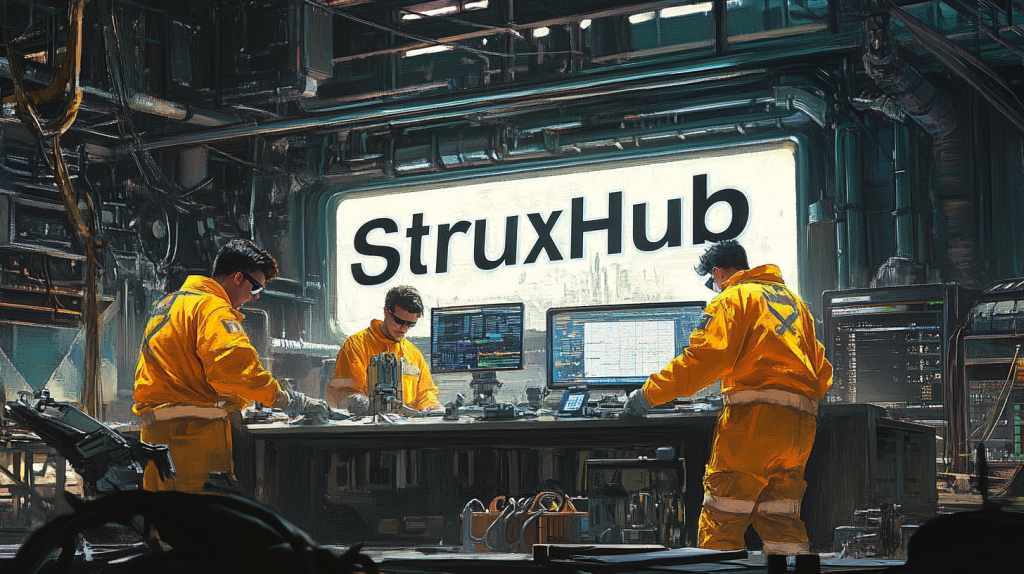
StruxHub
Experience the power of StruxHub today and witness firsthand how it can revolutionize your construction operations.
FAQ
How does construction management software help track solar panel deliveries?
Tracking solar panel deliveries is a critical component of solar farm construction, as any delay in receiving materials can significantly impact project timelines and installation schedules. Without real-time delivery tracking, contractors may face supply chain disruptions, misallocated resources, and increased labor costs.
1. Real-Time Shipment Tracking
One of the biggest challenges in solar farm construction is ensuring that solar panels, racking systems, and inverters arrive on-site at the right time. Construction management software like StruxHub provides:
- Live GPS tracking of shipments, ensuring that contractors know exactly when materials will arrive.
- Automated alerts and notifications to inform crews when deliveries are delayed or ahead of schedule.
- Barcode scanning and RFID tracking, reducing the risk of misplaced inventory once shipments arrive.
2. Preventing Material Shortages and Overstocking
A common issue in solar farm construction is ordering too many or too few panels, leading to budget overruns or project delays. With a smart inventory tracking system, teams can:
- Ensure that material requests align with project schedules.
- Monitor real-time stock levels and prevent shortages.
- Automatically generate purchase orders when supplies run low.
3. Integration with Workforce Scheduling
Having panels on-site is useless without crew availability to install them. Software like StruxHub integrates delivery tracking with workforce scheduling, ensuring that:
- Installation teams are scheduled when panels arrive.
- Logistics managers can adjust schedules dynamically based on delivery status.
By using construction management software, solar farm developers can track shipments in real-time, prevent material shortages, and optimize workforce scheduling, ensuring smooth project execution.
What features should I look for in solar farm project tracking software?
Choosing the right solar farm project tracking software is essential for streamlining workflows, reducing inefficiencies, and keeping projects on schedule. The best software should offer real-time job site monitoring, automated logistics tracking, compliance reporting, and workforce coordination tools.
1. Project Scheduling & Workforce Management
- Automates crew assignments and adjusts shifts dynamically based on real-time progress.
- Integrates with mobile apps so field workers can update task statuses instantly.
2. Real-Time Delivery & Inventory Tracking
- Monitors shipments of panels, inverters, racking, and transformers to prevent supply chain delays.
- Uses barcode scanning or RFID tracking to reduce inventory misplacement.
3. Compliance & Permitting Management
- Tracks environmental and safety regulations to prevent compliance violations.
- Provides automated permit tracking, reducing paperwork and approval delays.
4. Cloud-Based Access & Mobile Functionality
- Allows teams to access project data from anywhere.
- Sends push notifications for delivery updates, compliance deadlines, and job site changes.
The best solar farm project tracking software should include AI-powered scheduling, real-time logistics monitoring, compliance automation, and workforce coordination, ensuring seamless project execution.
How can StruxHub improve solar farm construction efficiency?
StruxHub is designed to streamline solar farm construction by providing end-to-end management tools for tracking materials, workforce schedules, site logistics, and compliance requirements.
1. Automated Material and Delivery Tracking
- Ensures that solar panels, inverters, and transformers arrive on schedule.
- Uses GPS and barcode scanning to track materials from suppliers to job sites.
- Reduces material shortages and delays, preventing costly downtime.
2. Workforce Coordination and Task Assignments
- Assigns crew tasks dynamically based on real-time project updates.
- Ensures that installation teams are deployed efficiently without idle time.
- Reduces scheduling conflicts between trade teams and subcontractors.
3. Compliance and Safety Automation
- Tracks OSHA and environmental compliance metrics to prevent regulatory fines.
- Automates safety checklists, audits, and incident reporting.
- Ensures that workers have the correct training certifications before working on-site.
4. Mobile Access and Cloud-Based Collaboration
- Enables superintendents and contractors to manage projects remotely.
- Allows workers to log progress reports, upload images, and flag issues from mobile devices.
StruxHub is a powerful tool for optimizing solar farm construction, helping firms reduce material delays, improve workforce efficiency, and ensure compliance with environmental and safety regulations.
How does compliance tracking software help with environmental regulations?
Solar farm construction projects must comply with environmental regulations, land-use policies, and grid interconnection requirements. Failing to meet these regulations can result in fines, project delays, or legal action. Compliance tracking software helps contractors and project managers stay ahead of regulatory requirements by automating documentation, reporting, and permitting workflows.
1. Environmental Impact Assessments
- Tracks permitting requirements and deadlines to prevent delays.
- Ensures that environmental impact reports are submitted on time.
- Automates regulatory filings to streamline compliance approval processes.
2. OSHA and Worker Safety Compliance
- Ensures that field workers follow OSHA safety protocols.
- Generates digital safety checklists and compliance reports.
- Tracks worker training and certification status to prevent violations.
3. Grid Interconnection and Energy Permits
- Manages applications for connecting solar farms to the utility grid.
- Tracks approval deadlines and utility requirements to prevent delays in energization.
4. StruxHub’s Role in Compliance Management
- Automates compliance tracking for environmental and safety regulations.
- Stores permitting documents in a centralized digital database for easy access.
- Notifies project managers of upcoming regulatory deadlines.
Conclusion
Compliance tracking software like StruxHub simplifies environmental and regulatory processes, ensuring that solar farm construction projects meet all necessary standards without costly delays.
